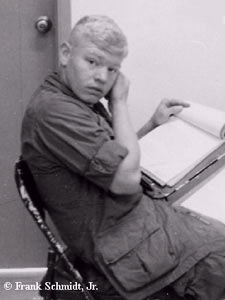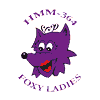Michael Kent NickersonFirst LieutenantHMM-364, MAG-16, 1ST MAW United States Marine Corps 30 December 1943 - 14 April 1969 Indianapolis, Indiana Panel 27W Line 080 |



| |
  
|

|
The database page for Michael Kent Nickerson
|
17 Aug 2003 Four men died on 14 April 1969 when CH-46A BuNo 153361 was shot down while on a medevac mission to "Charlie Ridge":
Michael Nickerson, and the other Purple Foxes who served in Vietnam, are remembered by the women who waited at home, whether mothers, sisters, wives, daughters, or friends. Those women, the continue to support today's Purple Foxes of HMM-364 as they serve our country.
Visit
A memorial initiated by the |
Notes from The Virtual WallIn the afternoon of 14 Apr 1969, HMM-364 was alerted for an emergency medevac in support of an element of Fox Company, 2/3 Marines. The pick-up was to be made on the south slope of "Charlie Ridge", a hill normally populated by "Victor Charlie" - hence the name. The pick-up aircraft, CH-46A BuNo 153361 (call sign "Yankee Kilo 5"), would be escorted by a second CH-46 and a pair of UH-1H gunships from HML-167.On arrival the gunships contacted the ground troops and were advised that they had not had contact with the enemy for some time. There was no available landing spot, so the pick-up would have to be made by lowering a hoist through a triple-canopy jungle while the pilot maintained a hover above the 100-foot trees. YK-5 entered the area with the two gunships in trail abreast, came to a hover, and lowered the jungle penatrator. As the penatrator approached the ground, YK-5 came under intense enemy fire, wounding both pilots and two of the other five crewmen, and shooting out the aircraft's hydraulic systems. As the pilot struggled to maintain control of the CH-46 he was hit again and killed. The wounded copilot took control of the faltering aircraft and attempted to autorotate down the slope of the ridge to the valley below but had neither airspeed, altitude, nor hydraulic controls. The CH-46 went into the trees. As it plunged through the jungle, two crewmen were thrown free before the aircaft stopped moving, nose-down and tail-up and beginning to burn. The two crewmen, both injured, found themselves on the right-hand side of the burning CH-46. They saw one man, apparently dead, still in the cargo bay - but no-one else. As munitions aboard the CH-46 began to cook off, the two withdrew to a safer distance and prepared to defend themselves with a single M-16. On the left side of the aircraft, invisible to the crewmen, the copilot had been thrown free on impact. Although his left arm was broken, he was able to assist three others, all injured, from the aircraft, and they too prepared to defend themselves - with the copilot's 38-caliber pistol. The CH-46 had gone down in heavy jungle about a quarter-mile distant from the Fox 2/3 element, there were enemy troops between the downed helicopter and the friendly force, and neither of the two groups of survivors knew the other was there. At this point even the weather turned against the downed crew: it began to rain. Back at Marble Mountain, the squadron Commanding Officer, LtCol Brady, ordered a CH-46 fitted out with additional machineguns - a total of five - and departed with a crew of nine others. As dusk approached, so too did the rescue helicopter ... and the copilot attracted his rescuers' attention by using his .38 to fire flare rounds at them. Fortunately the flares were not mistaken for tracers. Corporal James V. King was lowered by hoist, located the two isolated crewmen, and sent them up. A second uninjured Marine came down and assisted King in sending up the remaining three wounded crewmen, but they were forced to leave the two dead Marines with the wreckage. All during this time the CH-46 above was exchanging heavy fire with enemy troops, but nothing vital was hit aboard the aircraft. With the five survivors and two crewmen aboard, LtCol Brady withdrew. Unfortunately, one of the wounded died enroute to Danang. A day or so later an element from Lima 3/7 Marines walked into the jungle to retrieve the two Marines who had been left behind. The Yankee Kilo 5 crew consisted of
|
|
Top of Page
www.VirtualWall.org Back to |
With all respect
Jim Schueckler, former CW2, US Army
Ken Davis, Commander, United States Navy (Ret)
Memorial first published on 17 Aug 2003
Last updated 08/10/2009
